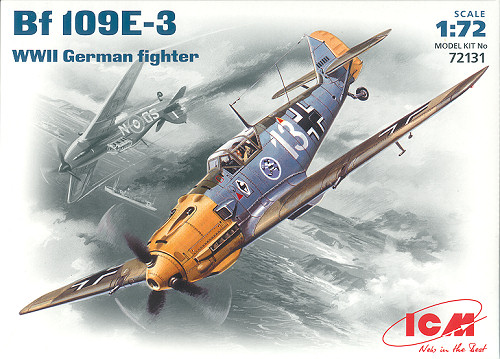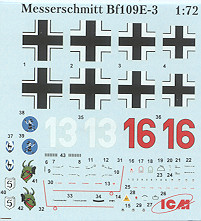
| KIT: | ICM 1/72 Bf-109E-3 |
| KIT #: | ? |
| PRICE: | $12.00 |
| DECALS: | Two options |
| REVIEWER: | Scott Van Aken |
| NOTES: |

| HISTORY |
By far the most successful German fighter of the late 1930s and into the very early 1940s was the Messerschmitt 109. The E model basically took the airframe of the Jumo powered variants and mated it with a much more powerful Daimler Benz DB 601 supercharged engine. It was with this aircraft that Germany went to war with Europe.
The original 109 was based on the smallest possible airframe that could be mated to the most powerful engine and still accomplish the tasks required. Though not the finest fighter when chosen, its ease of construction and lower unit costs made it the winner in the fighter competition from whence it was entered. This frequently happens where the less expensive weapon is chosen over one that could be more capable.
If the 109 had any vices, it was that it was not as maneuverable an aircraft as its opponents, and had a rear fuselage weakness that caused some problems as the aircraft started being used in heavy combat. It was also rather short ranged, a feature that was alleviated somewhat by addition of an external drop tank on the E-7 variant, but by then, the real need for it had passed, much to the detriment of the Luftwaffe. It was the short ranged E-1/3/4 versions that carried the battle across the Channel to the British and were eventually defeated due to their inability to stay with their bombers due to a lack of fuel.
| THE KIT |
 When
you open the box, your first impression is that this is the
Tamiya Bf-109E. While there are
a few differences, such as a multiple piece cockpit floor, and the parts are
laid out differently on the sprue, I'd be willing to bet that you could
interchange parts and find they fit without too much trouble.
When
you open the box, your first impression is that this is the
Tamiya Bf-109E. While there are
a few differences, such as a multiple piece cockpit floor, and the parts are
laid out differently on the sprue, I'd be willing to bet that you could
interchange parts and find they fit without too much trouble.
The kit is molded in white plastic and provides three
optional spinners for use on other versions as well as two sets of canopies and
two types of windscreen with an add on armor plate. Basically, you can do an E-4
with this kit by swa pping the
canopy bits. Can't do an E-7 as no drop tank or mount is included. If you want
to sand off and fill the cannon drum bulge on the bottom, you can do an E-1,
though to be totally accurate, you have to move the gun port openings on the
wing a bit.
pping the
canopy bits. Can't do an E-7 as no drop tank or mount is included. If you want
to sand off and fill the cannon drum bulge on the bottom, you can do an E-1,
though to be totally accurate, you have to move the gun port openings on the
wing a bit.
Instructions are well done with all the needed colors listed by Humbrol and generic terms. It would be nice to have the RLM shades as well, but most modelers will know that Matte Dark Green is RLM 71, Matte Black Green is RLM 70, Matte Aircraft Blue is RLM 65, Matte Slate Grey is RLM 02 (which I guess covers the biggies). Both marking options are in the RLM 71/02/65 scheme. Red 16 is from early 1940 and 2./JG 26 2with no mottling and a red spinner. The one on the box art is white 13 from 1./JG 51 with a yellow nose and rudder. Still no mottling so that helps when painting. This set of markings is shown on the back of the box in full color. The decal sheet is free of pesky swastikas so you'll have to dredge some up from another source. Markings are nicely printed but a teeny bit off register. This is not a problem as there are oodles of aftermarket sheets for the 109. A full stencil suite is provided as well.
| CONCLUSIONS |
So, you may be asking, why buy this one when I can get the Tamiya kit? Well, at least $5 difference in price is the real answer. With Testors importing ICM kits, finding these will be much easier than it has been in the past.
May 2006
Thanks to
 and DLV Company
for the review kit. You can find Italeri kits at your favorite hobby shop.
and DLV Company
for the review kit. You can find Italeri kits at your favorite hobby shop.
If you would like your product reviewed fairly and quickly by a site that has over 300,000 visitors a month, please contact me or see other details in the Note to Contributors.